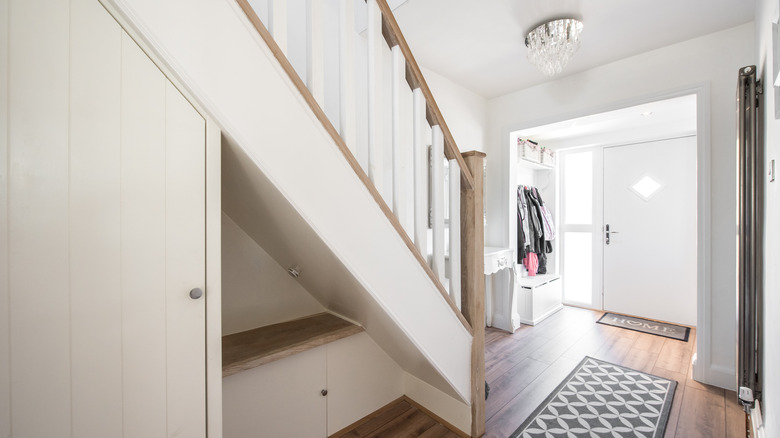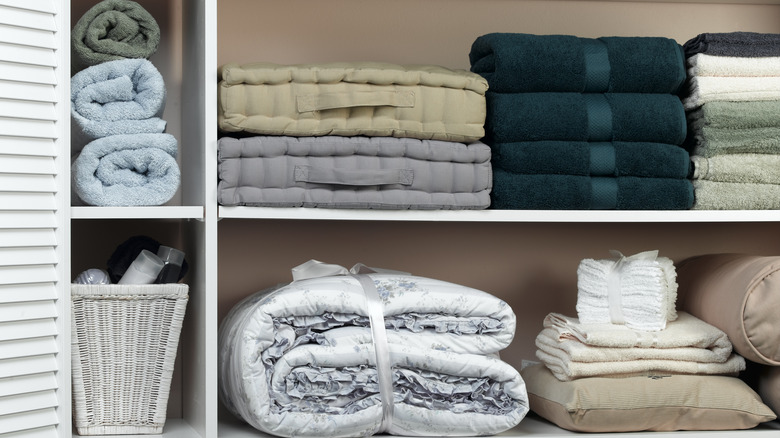Transform Your Under The Stairs Space Into The Perfect Cabinet Or Pantry
We may receive a commission on purchases made from links.
Figuring out how to use the closet below your stairs can be tricky, thanks to the space's odd dimensions and sloping ceiling. Though it's a great out-of-the-way spot for storing items, you're probably not making the most of it if you're just tossing in cleaning supplies, extra pairs of shoes, or miscellaneous holiday decorations into it. As with pretty much any other part of your home, the area under your stairs is a place where you can make the most of vertical space as a means of decluttering. With a little bit of creative magic, you might even be able to transform this closet into an elegant cabinet or pantry. All you need to do is install a few sets of floating shelves with a vertical divider between them at the highest point of the ceiling's slope.
To begin this project, you'll need a few finished wood planks, a handful of shelf brackets, and a can of paint in your preferred color. You'll also need a few everyday tools, such as your drill and stud finder, close at hand. If you don't have a saw, you can use your local home improvement center's lumber-cutting service. The idea for this DIY comes from YouTube creator The Moore The Merrier. In a brief tutorial video, the homeowners put a mix of glass jars and wooden crates on and below their shelves to make their new pantry an easy-to-navigate space that looks organized and inviting. The arrangement is definitely one of the best functional shelving ideas that will maximize space in your home.
Turning the closet under your stairs into a handy storage space
To get started, remove everything from the area and prime and paint the walls. Afterward, measure the distance between the floor and the highest point of the sloping part of the ceiling. Add painter's tape to the point where your tape measure meets the floor. This first measurement tells you how long your divider panel should be. Next, find the distance between the marked point on the floor and the base of the space's shortest wall. Subtract the thickness of your divider panel from this second measurement to determine how long your larger floating shelves should be. Finally, measure the length of the flat section of your ceiling, if present. This will be the run of your smaller floating shelves.
Now you can cut your divider panel and your shelves. Don't forget to add a bevel that matches the angle of your ceiling to the top end of your divider board. Next, decide how high you're going to put your shelves. Wherever possible, you should attach your shelf brackets to your studs, which you can locate with a stud finder. Install the larger shelves first so that they meet the shorter side of the wall. Then, fit the divider panel into place on their opposite side. Attach the panel to the shelves with wood screws and to the wall with polyurethane construction adhesive. Finally, install your smaller shelves and brackets on the far side of the divider.
Ideas for utilizing your new under the stairs storage system
Filling your new shelves with dry goods and kitchen supplies is just one of the ways you can utilize your under-the-stairs storage system. Another option is to keep sheets and towels here so that it functions like a linen closet instead. It will be easy to grab essential items since the room around your staircase is typically a high-traffic area of the house. If that idea doesn't sound like the best fit for your home, you could put the space to use by turning it into a makeshift wine cellar with glass racks and a stunning DIY wood project that every wine lover needs.
If you have a relatively tall closet under your stairs, you could hang up a handy set of hooks within it, such as this Optish Coat Rack Wall Mount, for storing bulky coats, beach bags, and other seasonal clothes. Operating with a smaller amount of square footage? You might be able to fill this space with your overflowing collection of books, board games, or DVDs, creating an entertainment storage of sorts. Regardless of how you're going to make use of your new shelves, you might want to think about the closet's lighting. If you don't already have an overhead fixture here, you can skip the electrical work by installing a set of adhesive under cabinet lights. MCGOR Rechargeable Motion Sensor Lights, for example, would be easy to stick to the bottom of your floating shelves and might make the space even more functional.

